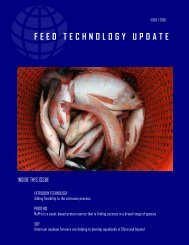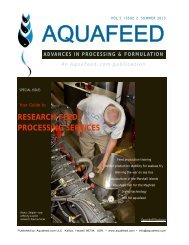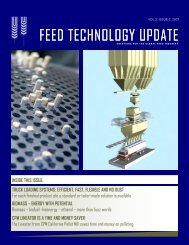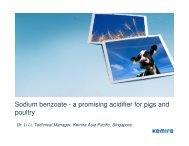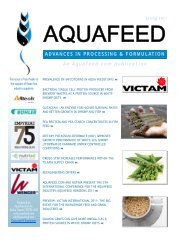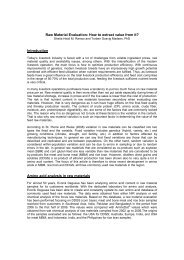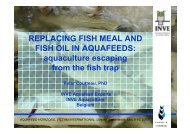Read Document - AquaFeed.com
Read Document - AquaFeed.com
Read Document - AquaFeed.com
Create successful ePaper yourself
Turn your PDF publications into a flip-book with our unique Google optimized e-Paper software.
36Impact of rising feed ingredient prices on aquafeeds and aquaculture productionFeeds range from single <strong>com</strong>ponent feeds available on-farm such as grass or rice branto farm-made formulated feeds and <strong>com</strong>mercial feeds. Feeds also can be simple farmmademoist or dry aquafeeds or formulated <strong>com</strong>mercially made aquafeeds. However,there is no clear definition for what is farm-made and non-farm made aquafeed andnon‐farm made aquafeeds. FAO suggests that farm-made feeds be defined as feeds inpellet or other forms, consisting of one or more artificial and/or natural feedstuffs,produced for the exclusive use of a particular farming activity and not for <strong>com</strong>mercialsale or profit. Kitchen waste may also be considered as one of the types of farm-madeaquafeed as per FAO definition as it contains one or more natural feedstuffs in nonpelletform. De Silva and Hasan (2007) suggest that mixtures of ingredients subjectedto some form of processing (simple mixing, grinding and cooking) done on-farm or insmall processing plants are generally regarded as farm-made aquafeeds and are often themainstay in small-scale semi-intensive aquaculture practices. Formulated <strong>com</strong>mercialfeeds are <strong>com</strong>posed of several ingredients, mixed in various proportions to <strong>com</strong>plementeach other, and form a nutritionally <strong>com</strong>plete <strong>com</strong>pounded diet. De Silva and Hasan(2007) categorized Asian aquafeeds into the following four groups.(i) materials and/or ingredients of plant origin that are used singly or in <strong>com</strong>binationwith others (of plant or animal origin) but with little or no processing;(ii) materials of animal origin, primarily trash fish, that are used singly or in<strong>com</strong>bination with others but with little or no processing;(iii) mixtures of ingredients that are subjected to some form of processing (simplegrinding, mixing and cooking), resulting in a moist dough or in simple pellets;and(iv) feeds that are manufactured in industrial feed milling plants and are distributedand sold using conventional market chains.A very wide range of ingredients is used to prepare farm-made aquafeeds. Theyinclude aquatic and terrestrial plants (duckweeds, Azolla, water hyacinth, etc.), aquaticanimals (snails, clams, etc.) and terrestrial-based live feeds (silkworm larvae, maggots,etc.), plant processing products (de-oiled cakes and meals, beans, grains and brans) andanimal-processing by-products (blood and feather meal, bone meal, etc.). Vegetableingredients are used singly or in <strong>com</strong>bination with other ingredients of plant or animalorigin as feeds with no or little processing in small-scale aquaculture at the lower end ofsemi-intensive practices, while material of animal origin such as trash fish is used singlyor in <strong>com</strong>bination with other ingredients with no or little processing at the upper endof semi-intensive practices (De Silva and Hasan, 2007). Usually in intensive practices,<strong>com</strong>mercial <strong>com</strong>plete feeds are used.Irrespective of the feed category, the majority of the ingredients used in the feeds,particularly in categories (iii) and (iv) above, are fairly <strong>com</strong>mon ingredients and includefishmeal, soybean meal, various oilseed cakes (De Silva and Hasan, 2007). Accordingto the FAO (2008b), aquaculture used 56 percent (3 million tonnes) of world fishmealproduction in 2006 and 87 percent (800 000 tonnes) of fish oil production. Tacon (2008)puts this even higher, at 3.7 million tonnes of meal and 840 000 tonnes of oil. For Asiaas a whole, the situation is further exacerbated as its contribution to the world supplyof these three principal ingredients is minimal in <strong>com</strong>parison to the proportion that isTable 24Ingredients used <strong>com</strong>monly as sources of protein, lipids and carbohydratesNutrient Ingredients used in Asia Ingredients used in EuropeProteinFishmeal, soybean meal, soy proteinconcentrate, maize gluten, wheat gluten,sunflower, CPSP, blood meal, meat mealFishmeal, soybean meal, soy proteinconcentrate, maize gluten, wheat gluten,sunflower, CPSP, blood meal, meat meal,krill meal, gelatin, brewer’s yeastLipid Fish oil, vegetable oil, tallow Fish oil, vegetable oil, tallowCarbohydrate Wheat meal, extruded wheat meal, wheat Wheat meal, extruded wheat meal, wheatremillings, extruded gelatinized starch remillings, extruded gelatinized starchSource: Compiled by the authors.



